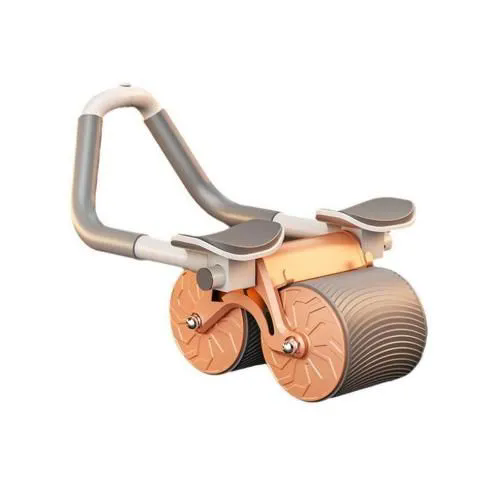Abdominal Wheel with Automatic Rebound Roll: Q&A Guide
2024-10-30
1. What Is an Abdominal Wheel with Automatic Rebound Roll?
The abdominal wheel with automatic rebound roll is a fitness tool designed to strengthen core muscles, particularly the abs. It features an internal spring mechanism that helps the wheel return to its starting position after rolling forward. This automatic rebound makes it easier for users to maintain form, providing support during intense workouts.
2. How Does the Automatic Rebound Function Work?
The automatic rebound system uses a spring mechanism inside the wheel. As you roll the wheel forward, the spring builds tension. When you begin to return, the spring releases the stored energy, assisting the user in rolling back to the starting position. This function helps reduce strain on the lower back and shoulders, making it more suitable for beginners or those recovering from injuries.
3. What Are the Benefits of Using an Abdominal Wheel with Automatic Rebound?
- Core strength: Engages not just the abdominal muscles but also the lower back, obliques, and hip flexors.
- Better control: The rebound feature ensures smooth movements, reducing the chance of injury.
- Joint support: Reduces the load on wrists and shoulders during the exercise.
- Progressive training: Suitable for both beginners and advanced users, as the rebound mechanism allows for gradual intensity adjustments.
- Improves stability: Enhances overall body balance and coordination by engaging multiple muscle groups.
4. Who Should Use an Abdominal Wheel with Automatic Rebound?
This tool is ideal for:
- Beginners: The rebound feature helps maintain proper form and makes the workout less intimidating.
- Athletes and advanced users: It provides an effective way to add variety to core routines.
- People with back issues: The wheel reduces stress on the lower back by assisting in the roll-back phase.
- Home fitness enthusiasts: It’s compact and easy to store, making it a practical choice for home workouts.
5. How Does It Differ from a Traditional Abdominal Wheel?
The main difference lies in the automatic rebound mechanism. In a traditional abdominal wheel, users must rely entirely on their core and arm strength to roll back, which can be challenging. With the automatic rebound feature, the wheel assists with the return motion, making it more beginner-friendly and reducing the risk of injury.
6. How Should You Use the Abdominal Wheel Safely?
1. Start on your knees: This reduces the strain on your lower back.
2. Engage your core: Keep your abs tight throughout the movement.
3. Roll forward slowly: Control the motion, extending as far as comfortable without arching your back.
4. Use the rebound feature to return: Let the wheel assist you in rolling back to the starting position.
5. Maintain proper breathing: Exhale as you roll out and inhale as you return.
7. What Muscles Does the Abdominal Wheel Target?
The abdominal wheel works multiple muscle groups, including:
- Rectus abdominis: The "six-pack" muscles.
- Obliques: The muscles along the sides of the waist.
- Erector spinae: Lower back muscles for spinal support.
- Shoulders and arms: Engage to stabilize the wheel during movement.
- Hip flexors: Assist in controlling the forward and backward motion.
8. Can Beginners Use the Abdominal Wheel with Rebound?
Yes, the automatic rebound mechanism makes it easier for beginners to use the wheel. It provides support during the return phase, allowing users to focus on their form without overexerting their muscles. Beginners should start with shorter rolls and gradually increase the range as they build strength.
9. How Often Should You Use the Abdominal Wheel?
For best results, aim to use the abdominal wheel 2-4 times per week. This allows your core muscles to recover between sessions while building strength. Each workout can include 3-5 sets of 10-15 repetitions, depending on your fitness level.
10. What Are Some Tips to Maximize Results?
- Start slow: Focus on form rather than speed or distance.
- Consistent practice: Use the wheel regularly to see improvements in core strength and endurance.
- Incorporate variety: Combine with planks, crunches, and other core exercises for a well-rounded workout.
- Use on a stable surface: Ensure the floor is non-slippery to avoid accidents.
- Stretch afterward: Stretch your abs, shoulders, and back to prevent muscle stiffness.
11. What Are the Key Features to Look for When Buying an Abdominal Wheel with Rebound?
- Sturdy construction: Ensure the wheel is made of high-quality materials like rubber-coated wheels and durable springs.
- Comfortable handles: Look for ergonomic, non-slip handles for a secure grip.
- Wide wheel design: A wider wheel provides better stability during rolls.
- Weight capacity: Ensure the wheel can support your weight for safe use.
- Portable design: Lightweight and compact models are easier to store and transport.
12. Is the Abdominal Wheel Effective for Weight Loss?
While the abdominal wheel focuses primarily on muscle toning and strengthening, it can contribute to weight loss as part of a comprehensive fitness routine. By engaging large muscle groups, it can raise your heart rate and burn calories. However, combining it with cardio exercises and a healthy diet will yield the best weight loss results.
Conclusion
The abdominal wheel with automatic rebound roll offers an effective way to build core strength, improve stability, and support your fitness journey. With its spring-assisted rebound mechanism, it makes core exercises more accessible to beginners while still challenging advanced users. Whether you’re looking to tone your abs or enhance your overall fitness, this tool can be a valuable addition to your workout routine. Stay consistent, focus on proper form, and enjoy the benefits of a stronger, healthier core!



